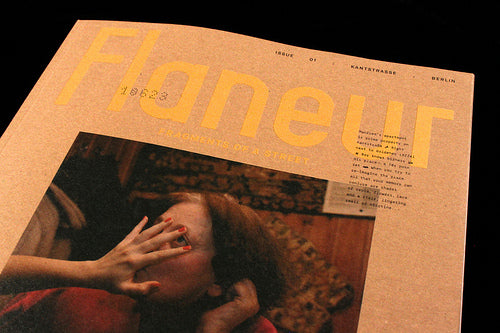
Magazine of the Week: Flaneur

‘Place’ has been a healthy starting point for a good few magCulture favourites. From Karen’s close-up stories built on her local friends and community to Boat’s wandering production studio, location is a strong source of character and identity. Emphasising the relationship with their surroundings can be the catalyst to explore and develop that editorial character. Berlins’s Der Wedding does so in an even more formal manner; named after one of the poorer, immigrant-populated districts of the city, it started life recording life in that specific area before latterly looking more broadly at everyday life in the city of Berlin. But if Boat deals with an entire city each issue, and Der Wedding takes on an area or theme of Berlin, new launch Flaneur zeroes in even more tightly. It is strictly one street per issue.

Flaneur arrives at a satisfyingly large-sized 240 x 320mm format and uses its 124 pages to reflect one of Berlin’s larger thoroughfares, Kantstrasse. This is, in the words of local friend Kati, ‘one of those streets I always send Berlin visitors after they’ve spent three days gushing over Mitte and Kreuzberg’. It is a reminder of the old West Berlin, a part of the city that has slowly faded while surviving on old reputations.

That’s the context; what’s the magazine like? One of the great things about setting such a tight editorial parameter is that the editors and designers have to get really creative to bring the subject alive. This they achieve really well. On a tactile level, the front cover is printed on rough brown stock and the pages inside switch between high gloss and matt. The large format means the look of pages can vary through the issue – a simple point but one worth making when so many new independents arrive in handy (and financially efficient) paperback-size. Each page is a large canvas.

Onto that canvas various invited artists, photographers and writers present their view of this one street. Maxime Ballesteros spent a night photographing the people in one bar; Fabian Saul pieces together fragments of cultural history linked to the street; there’s the story of a cat, as well as interviews with residents alongside architectural drawing style renditions of their apartements. Composer Malakoff Kowalski presents a musical score that reflects the sounds of Kantstrasse.

Perhaps the story of the whole street is best told via that of the Kantgaragen, a once state-of-the-art 1920s multistorey car park turned eyesore.

The issue promises only that ‘This could be Kantstrasse’ – these are personal views. But they add up to a unique portrayal of the life, history and culture of the street, and the fact it’s a busy, overlooked thouroughfare rather than one from a more hip part of town only makes it more intriguing. I’m already looking forward to the next street.


